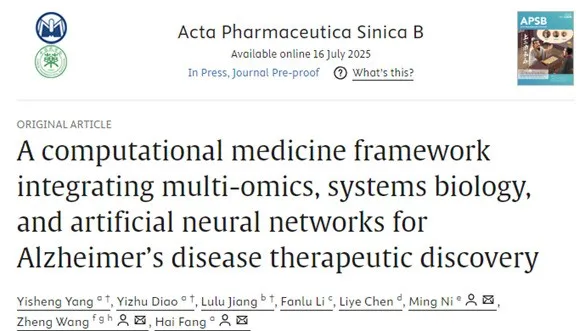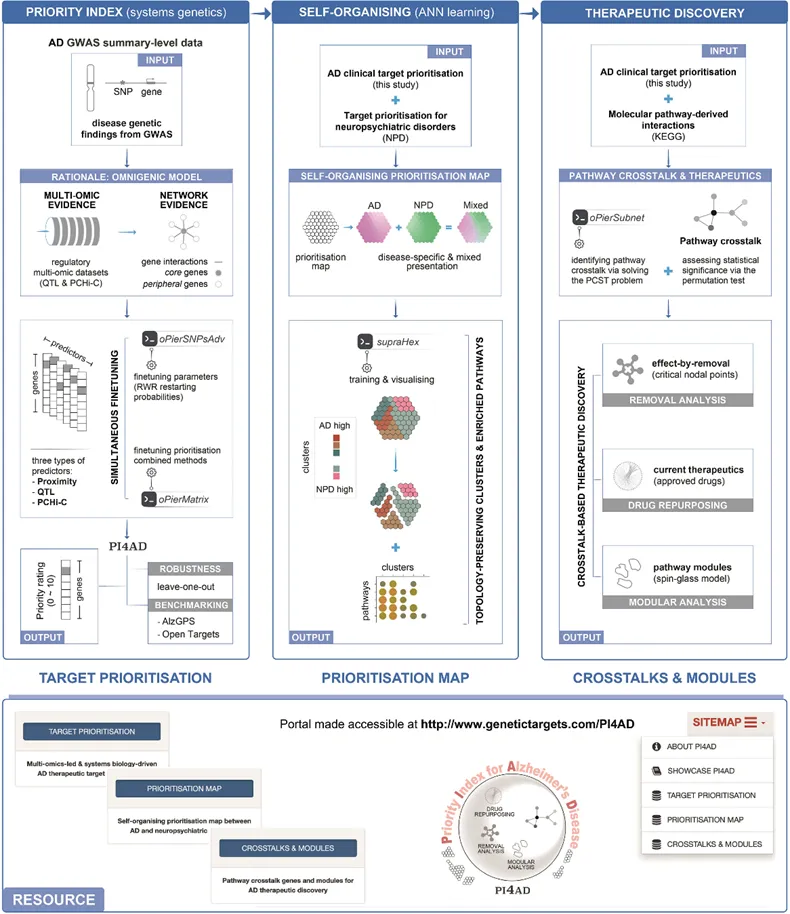
Recently, the team of Jinfeng Laboratory's Bio-Information Center cooperated with the Shanghai Jiaotong University team to international journalsActa Pharmaceutica Sinica B(TOP journal of District 1 of the Chinese Academy of Sciences, Impact factor: 14.4) published a research paper titled "A computing medicine framework integrating multi-omics, systems biology, and artistic neural networks for Alzheimer's disease therapeutic discovery".

The study developed a computing medicine framework that integrates multiomics data, systems biology, and artificial intelligence neural networks to discover potential treatments for Alzheimer's disease. The framework uses multiomics data and network evidence to achieve three core functions: clinical target prioritization, self-organized priority map construction (differentiating AD-specific targets with neuropsychiatric diseases-related targets), and pathway interaction-based therapeutic discovery. Under this framework, the researchers integrated AD-related genome-wide association study (GWAS) data, gene expression and proteome quantitative trait loci (QTL) data, as well as genome 3D interaction (PCHi-C) and other various omic evidence to construct a gene-predictor matrix. Combined with the random walk (RWR) algorithm in the gene network, they scored core genes and peripheral genes and prioritized multiple predictors using a meta-analysis method. To explore disease specificity, the study also used self-organized mapping (SOM) artificial neural network to cluster the priority genes of AD with other neuropsychiatric diseases (such as depression, schizophrenia, etc.). In terms of pathway crosstalk analysis, the team identified a "crosstalk network" composed of 51 highly connected genes from the above high-priority genes through the Prize-Collecting Steiner tree algorithm.

▲PI4AD built-in model and platform development flowchart.
PI4AD successfully re-identifies clinically validated targets such as APP and ESR1, confirming the effectiveness of its prioritization. Its artificial neural network module recognizes disease-specific molecular markers, while pathway interaction analysis reveals key node genes (such as HRAS and MAPK1), potential drug relocalization candidates, and clinically relevant network modules. By verifying targets, elucidating disease-specific therapeutic potential and exploring interaction mechanisms, PI4AD combines genetic insights with pathway-level biology, laying a systematic genetic foundation for the development of reasonable treatment options. The framework emphasizes that Ras-centric pathways are associated with synaptic dysfunction and neuroinflammation, providing a strategy for intervention in AD progression, complementing the traditional research paradigm focused on amyloid and Tau, and is expected to redefine therapeutic strategies in the future in combination with mRNA therapy, thereby advancing translational medicine in the field of neurodegenerative diseases.
Acta Pharmaceutica Sinica B (APSB) In the journal division of the Chinese Academy of Sciences, it belongs to the medical category 1 and the pharmaceutical sub-category 1. At the same time, it is also located in the Q1 district in the JCR division, mainly publishing high-quality research papers in all fields of pharmacy, including pharmacology, pharmacology, medicinal chemistry, natural products, pharmacology, drug analysis and pharmacokinetics.
Click on the lower left to read the original text and access the original text link.
https://pubs.acs.org/doi/10.1021/acsnano.5c02492